Big Data Analysis in Information Systems: Challenges and Support
VerifiedAdded on 2023/06/07
|9
|2077
|109
Report
AI Summary
This report provides an overview of big data, defining its characteristics such as volume, velocity, value, variety, and veracity. It explores the challenges in big data analytics, including the multitude of available technologies, lack of expertise, and heavy expenses. Various techniques for interpreting big data, like A/B testing, data mining, machine learning, and statistics, are discussed. The report further explains how big data technology supports businesses by reducing costs, informing pricing decisions, and improving decision-making processes. The report concludes that while big data presents challenges, it significantly impacts business organizations when effectively analyzed and utilized.
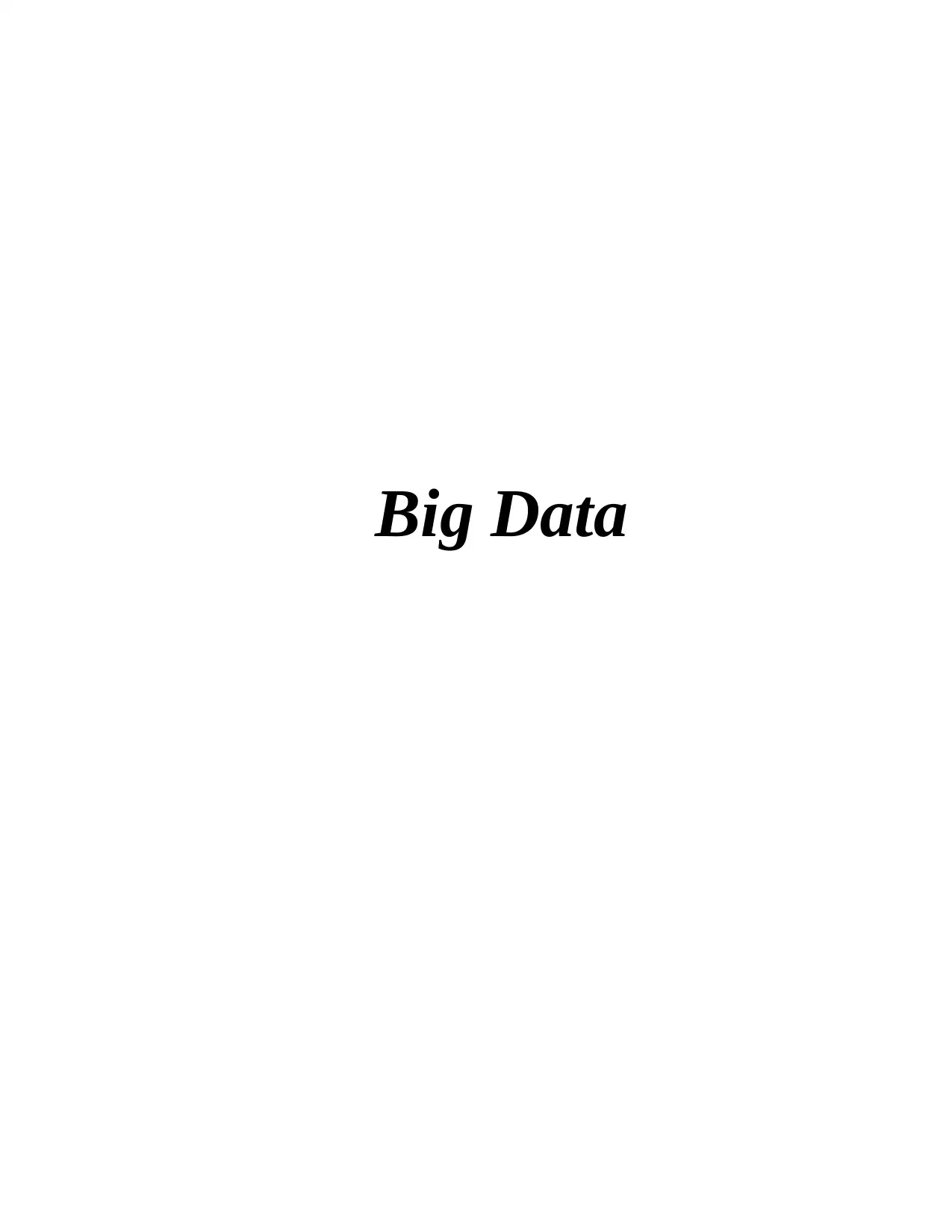
Big Data
Paraphrase This Document
Need a fresh take? Get an instant paraphrase of this document with our AI Paraphraser
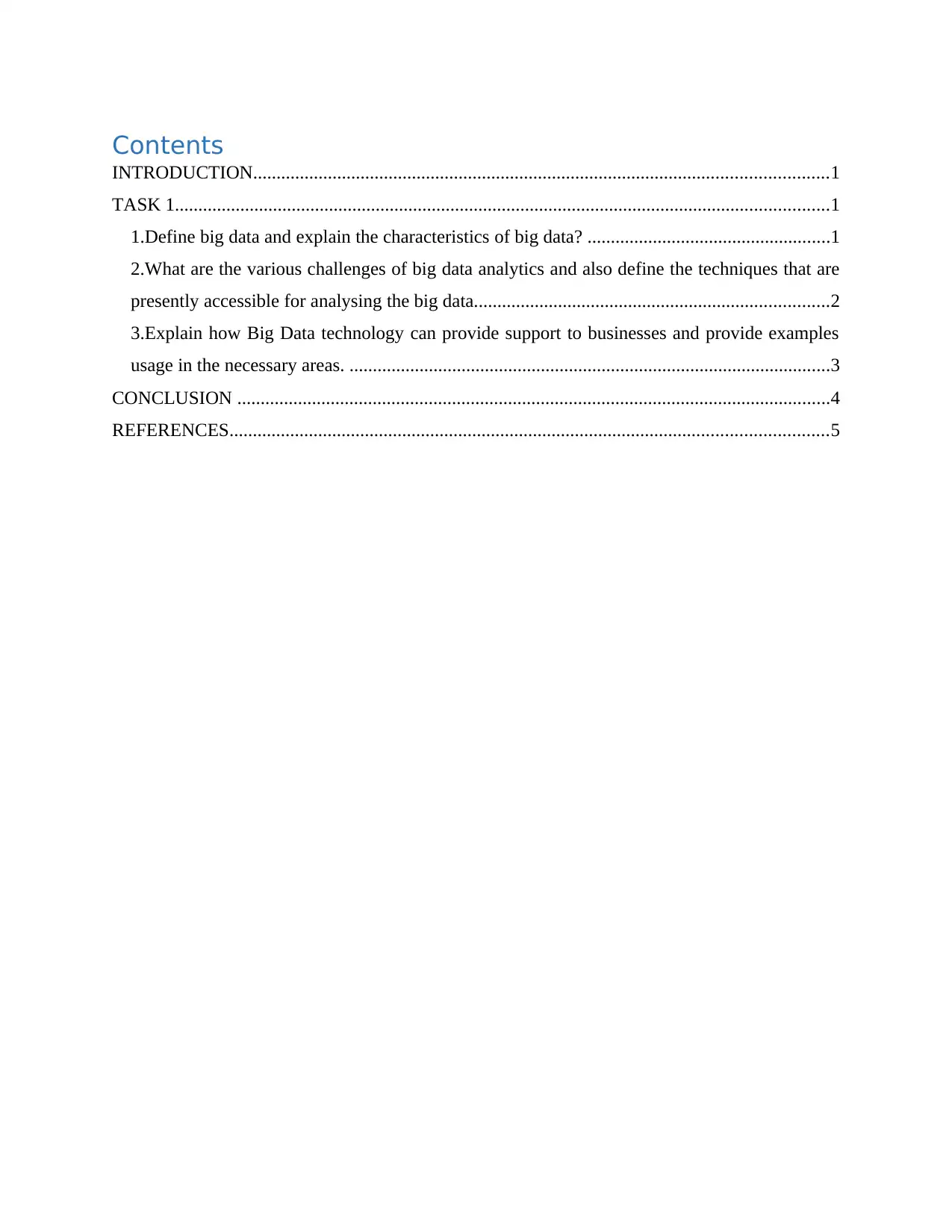
Contents
INTRODUCTION...........................................................................................................................1
TASK 1............................................................................................................................................1
1.Define big data and explain the characteristics of big data? ....................................................1
2.What are the various challenges of big data analytics and also define the techniques that are
presently accessible for analysing the big data............................................................................2
3.Explain how Big Data technology can provide support to businesses and provide examples
usage in the necessary areas. .......................................................................................................3
CONCLUSION ...............................................................................................................................4
REFERENCES................................................................................................................................5
INTRODUCTION...........................................................................................................................1
TASK 1............................................................................................................................................1
1.Define big data and explain the characteristics of big data? ....................................................1
2.What are the various challenges of big data analytics and also define the techniques that are
presently accessible for analysing the big data............................................................................2
3.Explain how Big Data technology can provide support to businesses and provide examples
usage in the necessary areas. .......................................................................................................3
CONCLUSION ...............................................................................................................................4
REFERENCES................................................................................................................................5

⊘ This is a preview!⊘
Do you want full access?
Subscribe today to unlock all pages.

Trusted by 1+ million students worldwide
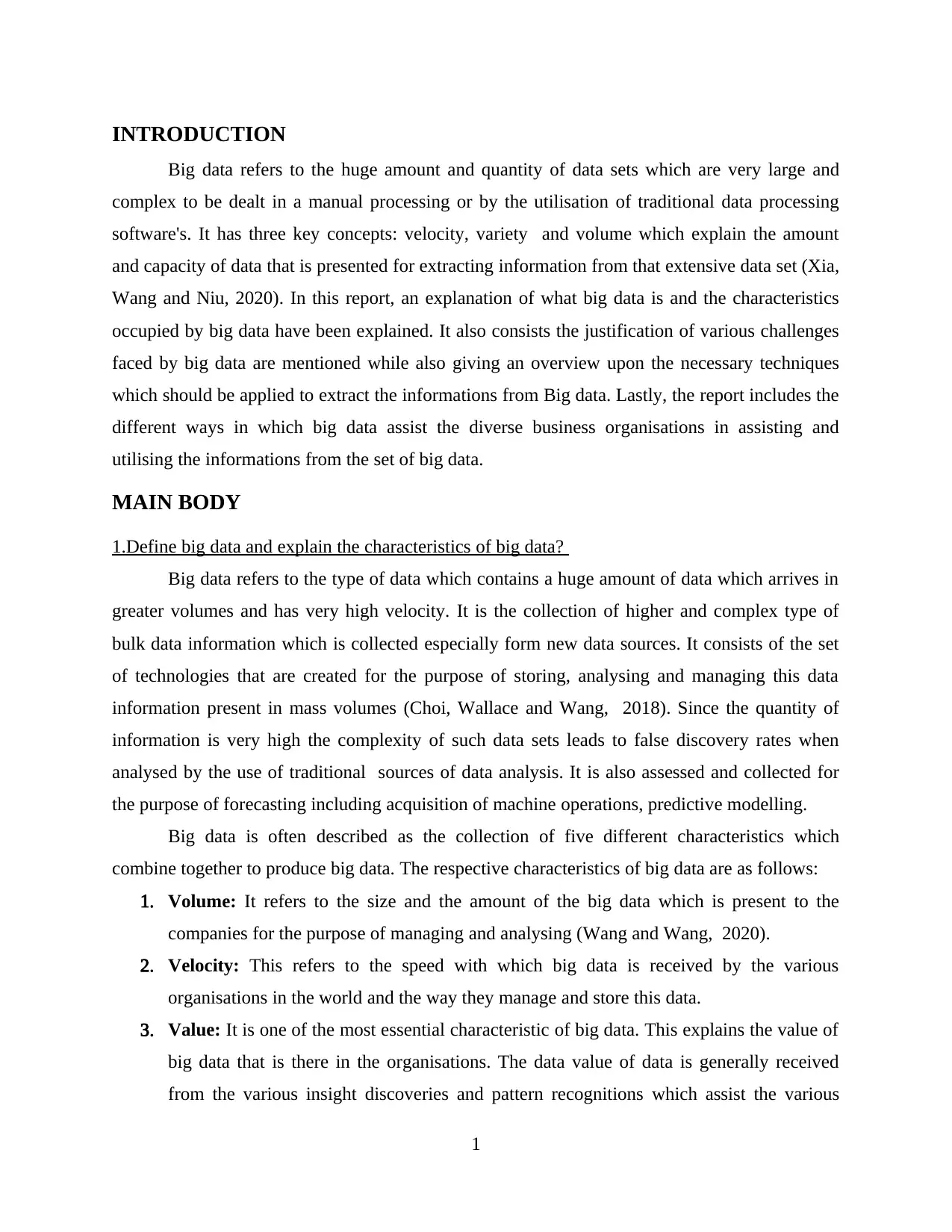
INTRODUCTION
Big data refers to the huge amount and quantity of data sets which are very large and
complex to be dealt in a manual processing or by the utilisation of traditional data processing
software's. It has three key concepts: velocity, variety and volume which explain the amount
and capacity of data that is presented for extracting information from that extensive data set (Xia,
Wang and Niu, 2020). In this report, an explanation of what big data is and the characteristics
occupied by big data have been explained. It also consists the justification of various challenges
faced by big data are mentioned while also giving an overview upon the necessary techniques
which should be applied to extract the informations from Big data. Lastly, the report includes the
different ways in which big data assist the diverse business organisations in assisting and
utilising the informations from the set of big data.
MAIN BODY
1.Define big data and explain the characteristics of big data?
Big data refers to the type of data which contains a huge amount of data which arrives in
greater volumes and has very high velocity. It is the collection of higher and complex type of
bulk data information which is collected especially form new data sources. It consists of the set
of technologies that are created for the purpose of storing, analysing and managing this data
information present in mass volumes (Choi, Wallace and Wang, 2018). Since the quantity of
information is very high the complexity of such data sets leads to false discovery rates when
analysed by the use of traditional sources of data analysis. It is also assessed and collected for
the purpose of forecasting including acquisition of machine operations, predictive modelling.
Big data is often described as the collection of five different characteristics which
combine together to produce big data. The respective characteristics of big data are as follows:
1. Volume: It refers to the size and the amount of the big data which is present to the
companies for the purpose of managing and analysing (Wang and Wang, 2020).
2. Velocity: This refers to the speed with which big data is received by the various
organisations in the world and the way they manage and store this data.
3. Value: It is one of the most essential characteristic of big data. This explains the value of
big data that is there in the organisations. The data value of data is generally received
from the various insight discoveries and pattern recognitions which assist the various
1
Big data refers to the huge amount and quantity of data sets which are very large and
complex to be dealt in a manual processing or by the utilisation of traditional data processing
software's. It has three key concepts: velocity, variety and volume which explain the amount
and capacity of data that is presented for extracting information from that extensive data set (Xia,
Wang and Niu, 2020). In this report, an explanation of what big data is and the characteristics
occupied by big data have been explained. It also consists the justification of various challenges
faced by big data are mentioned while also giving an overview upon the necessary techniques
which should be applied to extract the informations from Big data. Lastly, the report includes the
different ways in which big data assist the diverse business organisations in assisting and
utilising the informations from the set of big data.
MAIN BODY
1.Define big data and explain the characteristics of big data?
Big data refers to the type of data which contains a huge amount of data which arrives in
greater volumes and has very high velocity. It is the collection of higher and complex type of
bulk data information which is collected especially form new data sources. It consists of the set
of technologies that are created for the purpose of storing, analysing and managing this data
information present in mass volumes (Choi, Wallace and Wang, 2018). Since the quantity of
information is very high the complexity of such data sets leads to false discovery rates when
analysed by the use of traditional sources of data analysis. It is also assessed and collected for
the purpose of forecasting including acquisition of machine operations, predictive modelling.
Big data is often described as the collection of five different characteristics which
combine together to produce big data. The respective characteristics of big data are as follows:
1. Volume: It refers to the size and the amount of the big data which is present to the
companies for the purpose of managing and analysing (Wang and Wang, 2020).
2. Velocity: This refers to the speed with which big data is received by the various
organisations in the world and the way they manage and store this data.
3. Value: It is one of the most essential characteristic of big data. This explains the value of
big data that is there in the organisations. The data value of data is generally received
from the various insight discoveries and pattern recognitions which assist the various
1
Paraphrase This Document
Need a fresh take? Get an instant paraphrase of this document with our AI Paraphraser
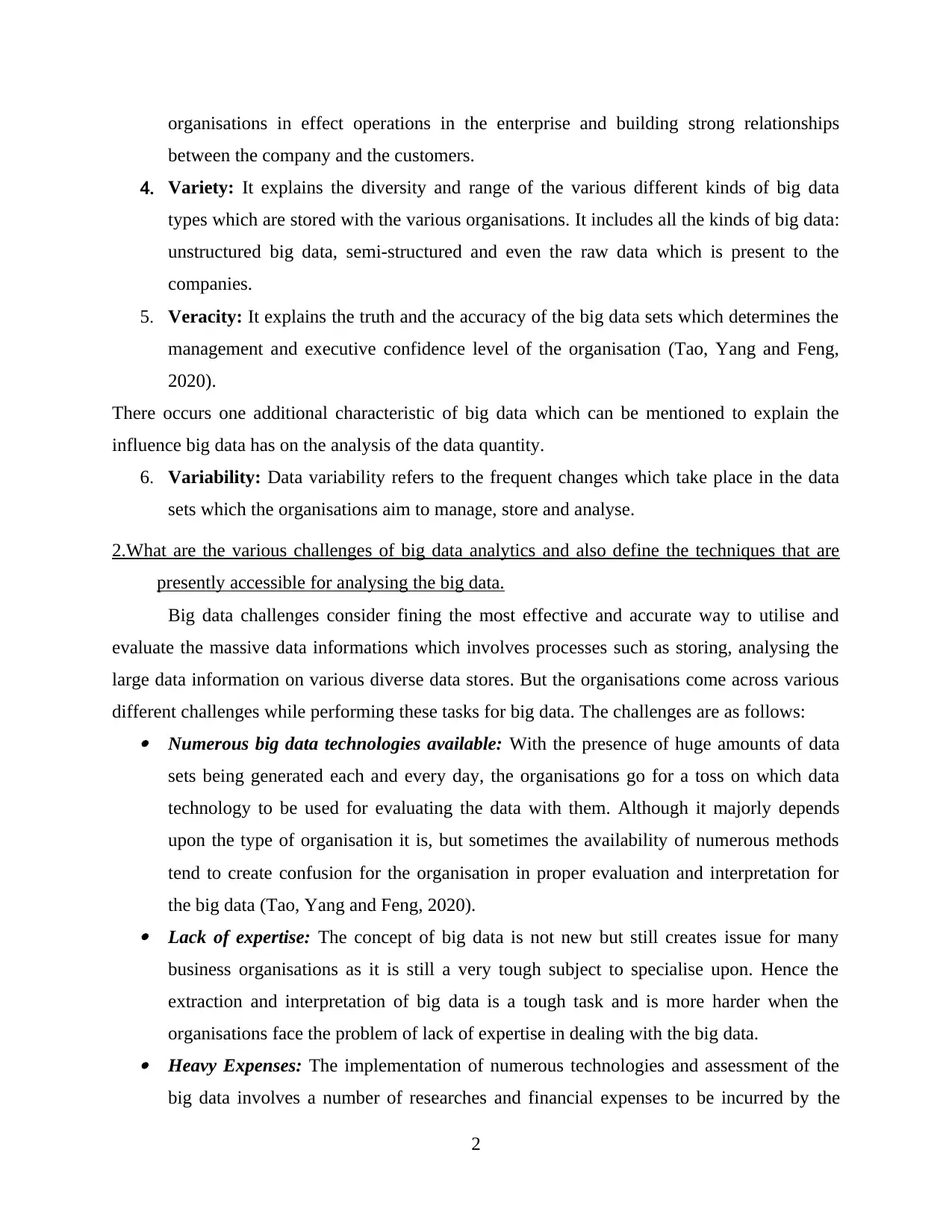
organisations in effect operations in the enterprise and building strong relationships
between the company and the customers.
4. Variety: It explains the diversity and range of the various different kinds of big data
types which are stored with the various organisations. It includes all the kinds of big data:
unstructured big data, semi-structured and even the raw data which is present to the
companies.
5. Veracity: It explains the truth and the accuracy of the big data sets which determines the
management and executive confidence level of the organisation (Tao, Yang and Feng,
2020).
There occurs one additional characteristic of big data which can be mentioned to explain the
influence big data has on the analysis of the data quantity.
6. Variability: Data variability refers to the frequent changes which take place in the data
sets which the organisations aim to manage, store and analyse.
2.What are the various challenges of big data analytics and also define the techniques that are
presently accessible for analysing the big data.
Big data challenges consider fining the most effective and accurate way to utilise and
evaluate the massive data informations which involves processes such as storing, analysing the
large data information on various diverse data stores. But the organisations come across various
different challenges while performing these tasks for big data. The challenges are as follows: Numerous big data technologies available: With the presence of huge amounts of data
sets being generated each and every day, the organisations go for a toss on which data
technology to be used for evaluating the data with them. Although it majorly depends
upon the type of organisation it is, but sometimes the availability of numerous methods
tend to create confusion for the organisation in proper evaluation and interpretation for
the big data (Tao, Yang and Feng, 2020). Lack of expertise: The concept of big data is not new but still creates issue for many
business organisations as it is still a very tough subject to specialise upon. Hence the
extraction and interpretation of big data is a tough task and is more harder when the
organisations face the problem of lack of expertise in dealing with the big data. Heavy Expenses: The implementation of numerous technologies and assessment of the
big data involves a number of researches and financial expenses to be incurred by the
2
between the company and the customers.
4. Variety: It explains the diversity and range of the various different kinds of big data
types which are stored with the various organisations. It includes all the kinds of big data:
unstructured big data, semi-structured and even the raw data which is present to the
companies.
5. Veracity: It explains the truth and the accuracy of the big data sets which determines the
management and executive confidence level of the organisation (Tao, Yang and Feng,
2020).
There occurs one additional characteristic of big data which can be mentioned to explain the
influence big data has on the analysis of the data quantity.
6. Variability: Data variability refers to the frequent changes which take place in the data
sets which the organisations aim to manage, store and analyse.
2.What are the various challenges of big data analytics and also define the techniques that are
presently accessible for analysing the big data.
Big data challenges consider fining the most effective and accurate way to utilise and
evaluate the massive data informations which involves processes such as storing, analysing the
large data information on various diverse data stores. But the organisations come across various
different challenges while performing these tasks for big data. The challenges are as follows: Numerous big data technologies available: With the presence of huge amounts of data
sets being generated each and every day, the organisations go for a toss on which data
technology to be used for evaluating the data with them. Although it majorly depends
upon the type of organisation it is, but sometimes the availability of numerous methods
tend to create confusion for the organisation in proper evaluation and interpretation for
the big data (Tao, Yang and Feng, 2020). Lack of expertise: The concept of big data is not new but still creates issue for many
business organisations as it is still a very tough subject to specialise upon. Hence the
extraction and interpretation of big data is a tough task and is more harder when the
organisations face the problem of lack of expertise in dealing with the big data. Heavy Expenses: The implementation of numerous technologies and assessment of the
big data involves a number of researches and financial expenses to be incurred by the
2
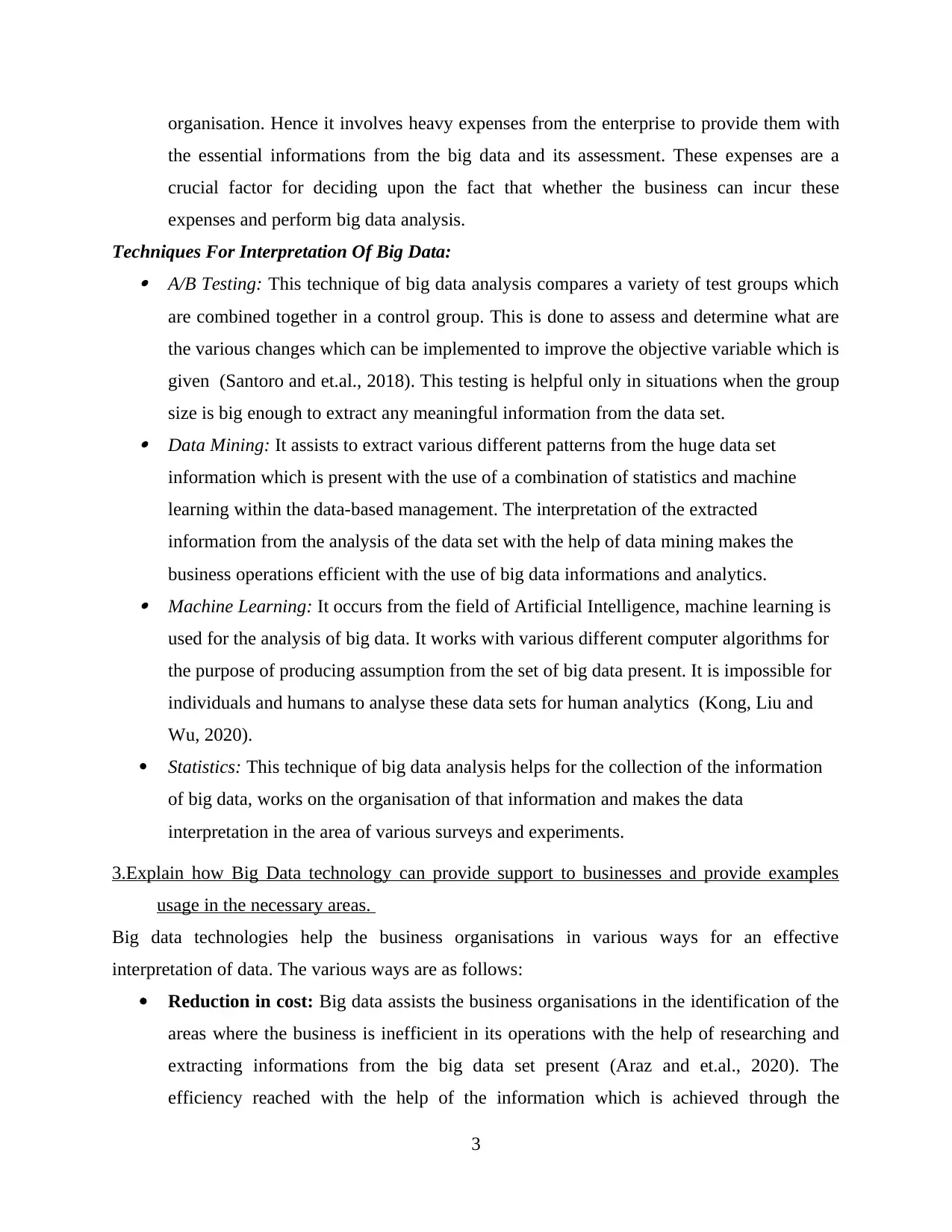
organisation. Hence it involves heavy expenses from the enterprise to provide them with
the essential informations from the big data and its assessment. These expenses are a
crucial factor for deciding upon the fact that whether the business can incur these
expenses and perform big data analysis.
Techniques For Interpretation Of Big Data: A/B Testing: This technique of big data analysis compares a variety of test groups which
are combined together in a control group. This is done to assess and determine what are
the various changes which can be implemented to improve the objective variable which is
given (Santoro and et.al., 2018). This testing is helpful only in situations when the group
size is big enough to extract any meaningful information from the data set. Data Mining: It assists to extract various different patterns from the huge data set
information which is present with the use of a combination of statistics and machine
learning within the data-based management. The interpretation of the extracted
information from the analysis of the data set with the help of data mining makes the
business operations efficient with the use of big data informations and analytics. Machine Learning: It occurs from the field of Artificial Intelligence, machine learning is
used for the analysis of big data. It works with various different computer algorithms for
the purpose of producing assumption from the set of big data present. It is impossible for
individuals and humans to analyse these data sets for human analytics (Kong, Liu and
Wu, 2020).
Statistics: This technique of big data analysis helps for the collection of the information
of big data, works on the organisation of that information and makes the data
interpretation in the area of various surveys and experiments.
3.Explain how Big Data technology can provide support to businesses and provide examples
usage in the necessary areas.
Big data technologies help the business organisations in various ways for an effective
interpretation of data. The various ways are as follows:
Reduction in cost: Big data assists the business organisations in the identification of the
areas where the business is inefficient in its operations with the help of researching and
extracting informations from the big data set present (Araz and et.al., 2020). The
efficiency reached with the help of the information which is achieved through the
3
the essential informations from the big data and its assessment. These expenses are a
crucial factor for deciding upon the fact that whether the business can incur these
expenses and perform big data analysis.
Techniques For Interpretation Of Big Data: A/B Testing: This technique of big data analysis compares a variety of test groups which
are combined together in a control group. This is done to assess and determine what are
the various changes which can be implemented to improve the objective variable which is
given (Santoro and et.al., 2018). This testing is helpful only in situations when the group
size is big enough to extract any meaningful information from the data set. Data Mining: It assists to extract various different patterns from the huge data set
information which is present with the use of a combination of statistics and machine
learning within the data-based management. The interpretation of the extracted
information from the analysis of the data set with the help of data mining makes the
business operations efficient with the use of big data informations and analytics. Machine Learning: It occurs from the field of Artificial Intelligence, machine learning is
used for the analysis of big data. It works with various different computer algorithms for
the purpose of producing assumption from the set of big data present. It is impossible for
individuals and humans to analyse these data sets for human analytics (Kong, Liu and
Wu, 2020).
Statistics: This technique of big data analysis helps for the collection of the information
of big data, works on the organisation of that information and makes the data
interpretation in the area of various surveys and experiments.
3.Explain how Big Data technology can provide support to businesses and provide examples
usage in the necessary areas.
Big data technologies help the business organisations in various ways for an effective
interpretation of data. The various ways are as follows:
Reduction in cost: Big data assists the business organisations in the identification of the
areas where the business is inefficient in its operations with the help of researching and
extracting informations from the big data set present (Araz and et.al., 2020). The
efficiency reached with the help of the information which is achieved through the
3
⊘ This is a preview!⊘
Do you want full access?
Subscribe today to unlock all pages.

Trusted by 1+ million students worldwide
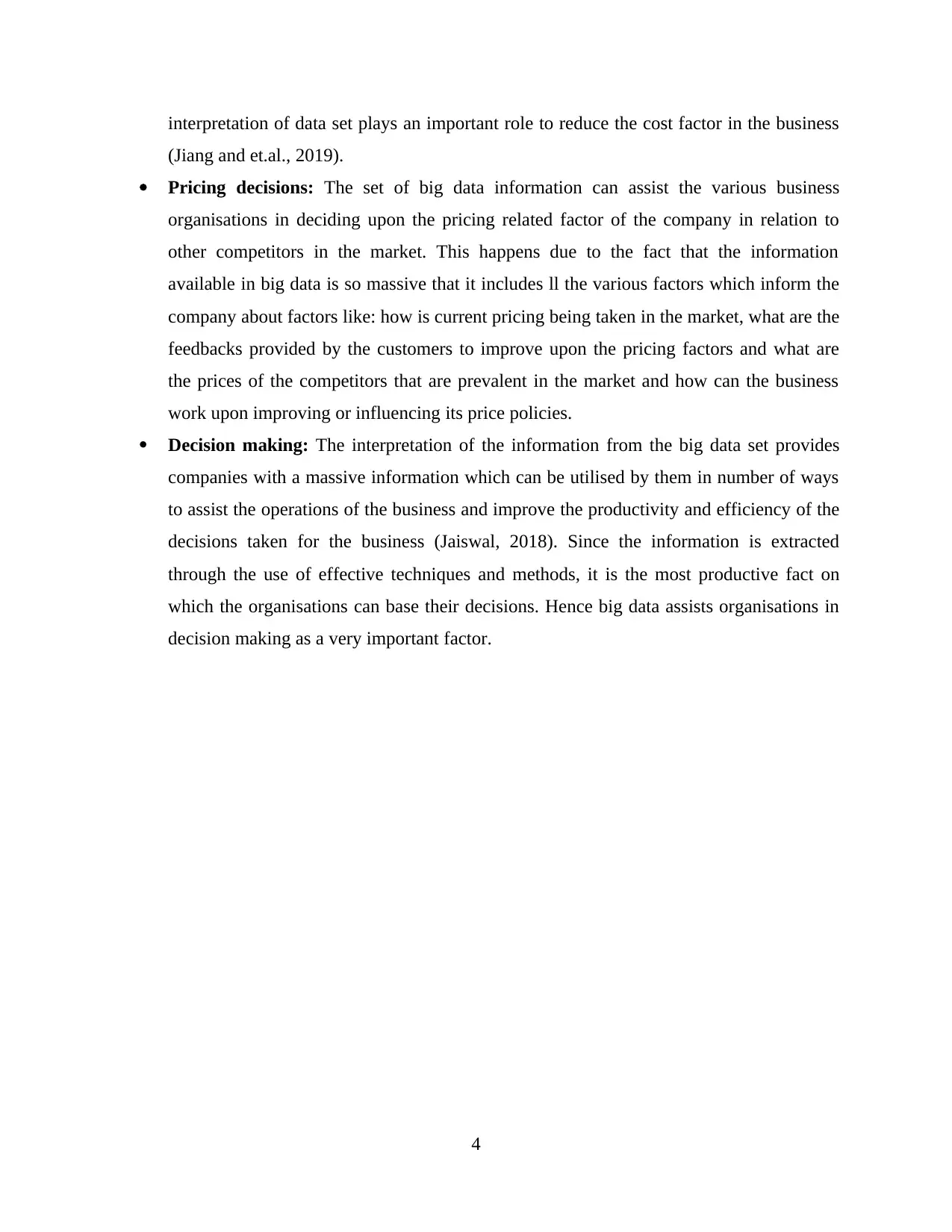
interpretation of data set plays an important role to reduce the cost factor in the business
(Jiang and et.al., 2019).
Pricing decisions: The set of big data information can assist the various business
organisations in deciding upon the pricing related factor of the company in relation to
other competitors in the market. This happens due to the fact that the information
available in big data is so massive that it includes ll the various factors which inform the
company about factors like: how is current pricing being taken in the market, what are the
feedbacks provided by the customers to improve upon the pricing factors and what are
the prices of the competitors that are prevalent in the market and how can the business
work upon improving or influencing its price policies.
Decision making: The interpretation of the information from the big data set provides
companies with a massive information which can be utilised by them in number of ways
to assist the operations of the business and improve the productivity and efficiency of the
decisions taken for the business (Jaiswal, 2018). Since the information is extracted
through the use of effective techniques and methods, it is the most productive fact on
which the organisations can base their decisions. Hence big data assists organisations in
decision making as a very important factor.
4
(Jiang and et.al., 2019).
Pricing decisions: The set of big data information can assist the various business
organisations in deciding upon the pricing related factor of the company in relation to
other competitors in the market. This happens due to the fact that the information
available in big data is so massive that it includes ll the various factors which inform the
company about factors like: how is current pricing being taken in the market, what are the
feedbacks provided by the customers to improve upon the pricing factors and what are
the prices of the competitors that are prevalent in the market and how can the business
work upon improving or influencing its price policies.
Decision making: The interpretation of the information from the big data set provides
companies with a massive information which can be utilised by them in number of ways
to assist the operations of the business and improve the productivity and efficiency of the
decisions taken for the business (Jaiswal, 2018). Since the information is extracted
through the use of effective techniques and methods, it is the most productive fact on
which the organisations can base their decisions. Hence big data assists organisations in
decision making as a very important factor.
4
Paraphrase This Document
Need a fresh take? Get an instant paraphrase of this document with our AI Paraphraser
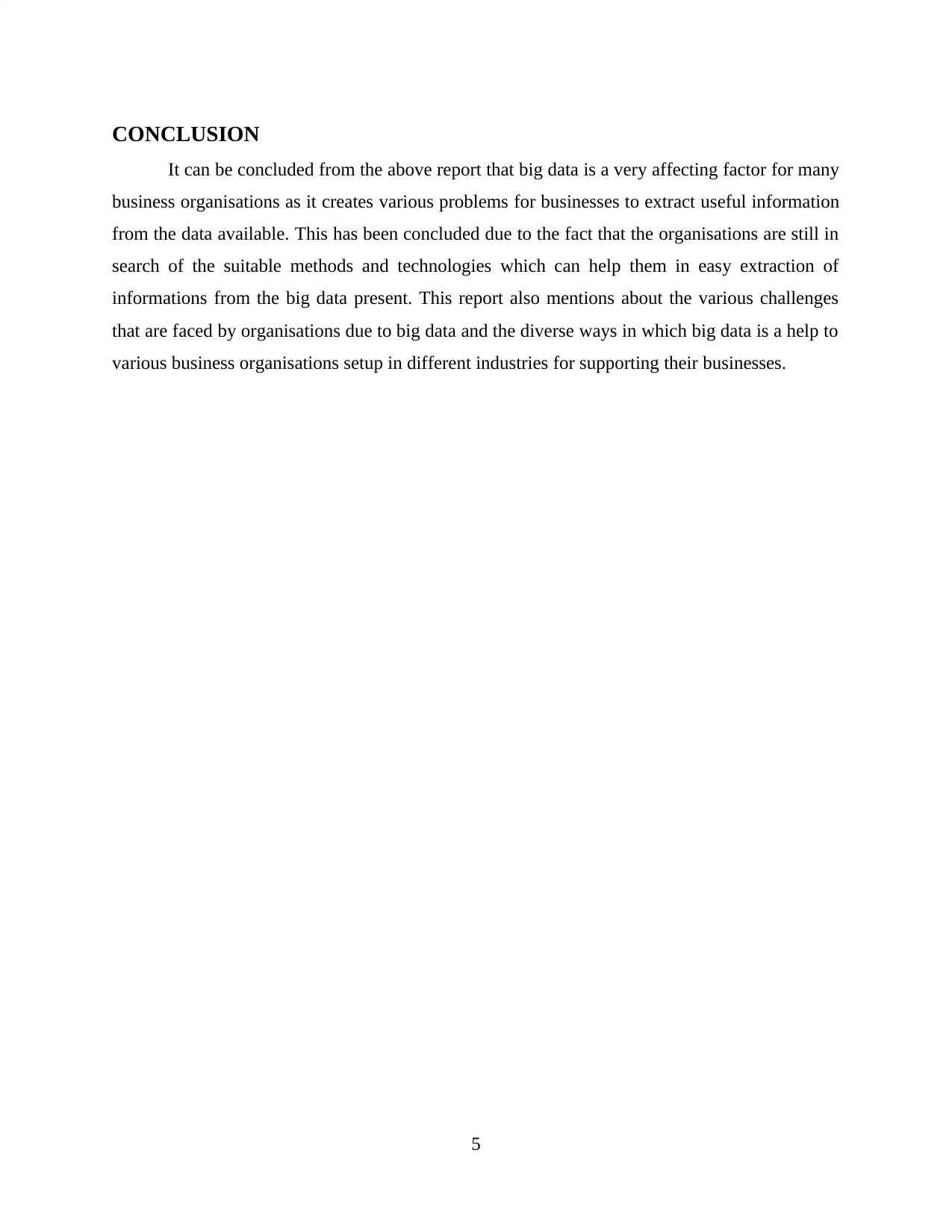
CONCLUSION
It can be concluded from the above report that big data is a very affecting factor for many
business organisations as it creates various problems for businesses to extract useful information
from the data available. This has been concluded due to the fact that the organisations are still in
search of the suitable methods and technologies which can help them in easy extraction of
informations from the big data present. This report also mentions about the various challenges
that are faced by organisations due to big data and the diverse ways in which big data is a help to
various business organisations setup in different industries for supporting their businesses.
5
It can be concluded from the above report that big data is a very affecting factor for many
business organisations as it creates various problems for businesses to extract useful information
from the data available. This has been concluded due to the fact that the organisations are still in
search of the suitable methods and technologies which can help them in easy extraction of
informations from the big data present. This report also mentions about the various challenges
that are faced by organisations due to big data and the diverse ways in which big data is a help to
various business organisations setup in different industries for supporting their businesses.
5
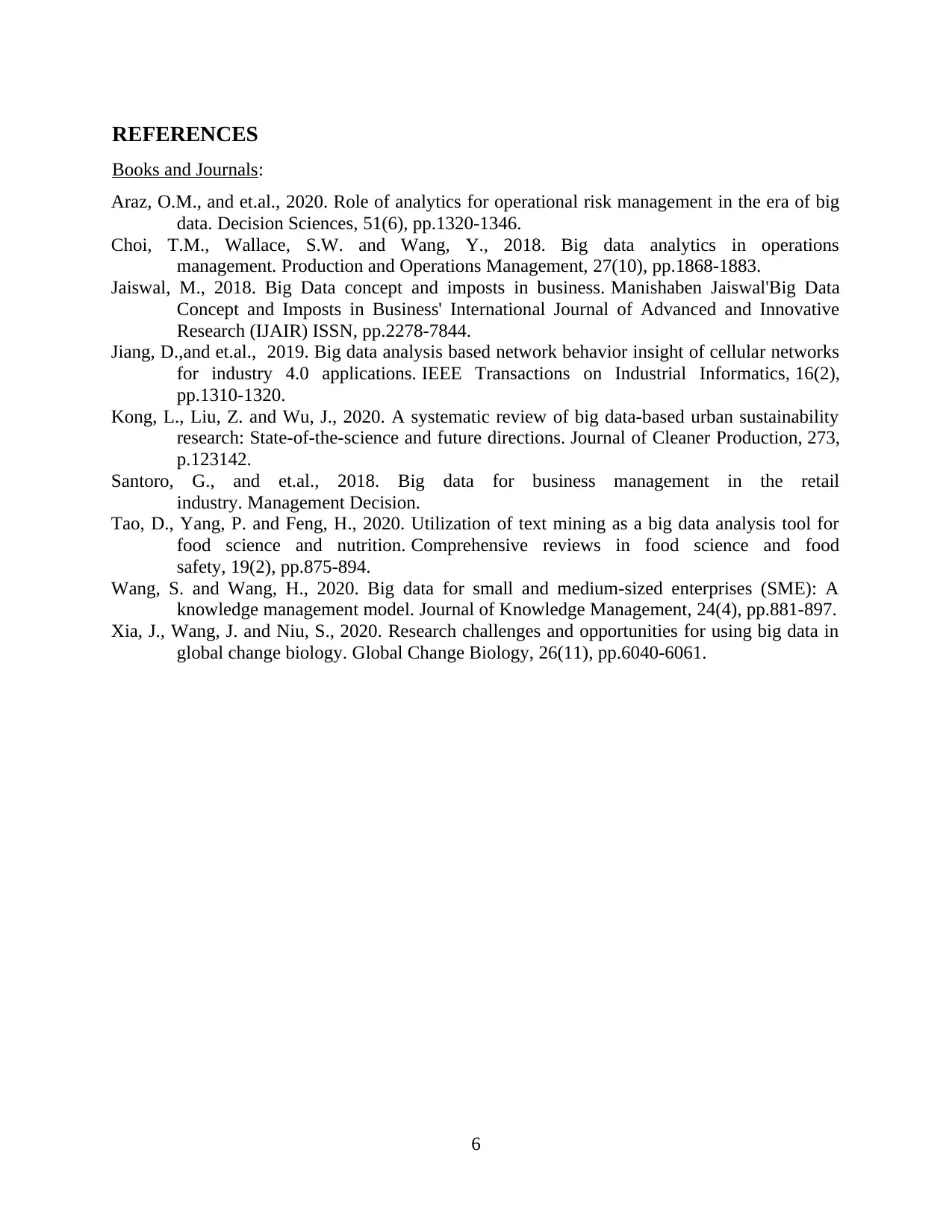
REFERENCES
Books and Journals:
Araz, O.M., and et.al., 2020. Role of analytics for operational risk management in the era of big
data. Decision Sciences, 51(6), pp.1320-1346.
Choi, T.M., Wallace, S.W. and Wang, Y., 2018. Big data analytics in operations
management. Production and Operations Management, 27(10), pp.1868-1883.
Jaiswal, M., 2018. Big Data concept and imposts in business. Manishaben Jaiswal'Big Data
Concept and Imposts in Business' International Journal of Advanced and Innovative
Research (IJAIR) ISSN, pp.2278-7844.
Jiang, D.,and et.al., 2019. Big data analysis based network behavior insight of cellular networks
for industry 4.0 applications. IEEE Transactions on Industrial Informatics, 16(2),
pp.1310-1320.
Kong, L., Liu, Z. and Wu, J., 2020. A systematic review of big data-based urban sustainability
research: State-of-the-science and future directions. Journal of Cleaner Production, 273,
p.123142.
Santoro, G., and et.al., 2018. Big data for business management in the retail
industry. Management Decision.
Tao, D., Yang, P. and Feng, H., 2020. Utilization of text mining as a big data analysis tool for
food science and nutrition. Comprehensive reviews in food science and food
safety, 19(2), pp.875-894.
Wang, S. and Wang, H., 2020. Big data for small and medium-sized enterprises (SME): A
knowledge management model. Journal of Knowledge Management, 24(4), pp.881-897.
Xia, J., Wang, J. and Niu, S., 2020. Research challenges and opportunities for using big data in
global change biology. Global Change Biology, 26(11), pp.6040-6061.
6
Books and Journals:
Araz, O.M., and et.al., 2020. Role of analytics for operational risk management in the era of big
data. Decision Sciences, 51(6), pp.1320-1346.
Choi, T.M., Wallace, S.W. and Wang, Y., 2018. Big data analytics in operations
management. Production and Operations Management, 27(10), pp.1868-1883.
Jaiswal, M., 2018. Big Data concept and imposts in business. Manishaben Jaiswal'Big Data
Concept and Imposts in Business' International Journal of Advanced and Innovative
Research (IJAIR) ISSN, pp.2278-7844.
Jiang, D.,and et.al., 2019. Big data analysis based network behavior insight of cellular networks
for industry 4.0 applications. IEEE Transactions on Industrial Informatics, 16(2),
pp.1310-1320.
Kong, L., Liu, Z. and Wu, J., 2020. A systematic review of big data-based urban sustainability
research: State-of-the-science and future directions. Journal of Cleaner Production, 273,
p.123142.
Santoro, G., and et.al., 2018. Big data for business management in the retail
industry. Management Decision.
Tao, D., Yang, P. and Feng, H., 2020. Utilization of text mining as a big data analysis tool for
food science and nutrition. Comprehensive reviews in food science and food
safety, 19(2), pp.875-894.
Wang, S. and Wang, H., 2020. Big data for small and medium-sized enterprises (SME): A
knowledge management model. Journal of Knowledge Management, 24(4), pp.881-897.
Xia, J., Wang, J. and Niu, S., 2020. Research challenges and opportunities for using big data in
global change biology. Global Change Biology, 26(11), pp.6040-6061.
6
⊘ This is a preview!⊘
Do you want full access?
Subscribe today to unlock all pages.

Trusted by 1+ million students worldwide
1 out of 9
Related Documents
Your All-in-One AI-Powered Toolkit for Academic Success.
+13062052269
info@desklib.com
Available 24*7 on WhatsApp / Email
![[object Object]](/_next/static/media/star-bottom.7253800d.svg)
Unlock your academic potential
Copyright © 2020–2025 A2Z Services. All Rights Reserved. Developed and managed by ZUCOL.



